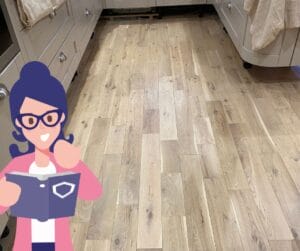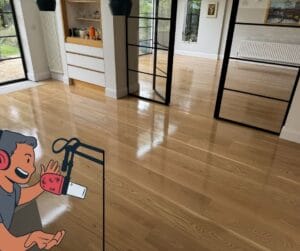If you’ve landed here, you probably want to know, “Can you stain your pine wood floor a different colour?” even if you have ever wondered that, you’re in the right place.
Welcome to our latest blog, where we explore the fascinating world of pine wood floors and how you can transform them with the magic of staining. We will be joined by Pierre Duet, one of the founders of Art of Clean, as he shares his expertise and insights on this exciting topic.
Before we dive into the blog, I know some of you would prefer to watch a short video as your time is very precious, and that would be far easier… if this is the case for you, our video below is especially for you:
If you are an avid reader and would much rather read about this topic, please read on…
A Brief History of Pine Wood Floors
Before diving into the staining process, it’s essential to understand the background of pine wood floors. Many older homes, especially those built during the Victorian and Georgian eras, featured pine wood floors that were initially subfloors for various coverings. These floors were commonly covered with rag rugs or other materials to keep the property warm. Later, fitted carpets became a popular choice, which further concealed these pine floors. Over time, as people started to appreciate hard surfaces, they uncovered the hidden treasure of wooden floors. However, it’s crucial to note that these pine floors were not originally for sanding and finishing.
Factors to Consider when Choosing a Stain
Before you choose a stain for your pine wood floor, you must consider several key factors. Firstly, you should examine the history of the floor to determine if they replaced any boards or if the timber comes from different sources, as this can result in uneven staining. Additionally, the type of pine used can significantly impact the final result. The faster-growing pine varieties used in more modern properties tend to be softer and less suitable for staining. On the other hand, the slower-growing Victorian-style pine boasts a beautiful deep orange colour, making it an excellent choice for staining.
Preparing Your Pine Wood Floor for Staining
If you’ve decided to stain your pine wood floor, it’s essential to follow specific steps to ensure optimal results. Sanding the floor thoroughly is crucial, starting with a coarse grit like 40 and gradually moving to finer grits, ending with 120 ideally. Some stains, like the Pallmann colour concentrates, can provide a more uniform finish, making it a popular choice for pine wood floors. Alternatively, Pall-X Pure, a white-pigmented finish, can transform the orangey hue of the pine into a lighter, more modern colour.
If using oil to finish your pine wood floor, you would need to follow the process of water popping to open up the pores in the wood. This process allows for the finish to penetrate the wood efficiently.
Impact of Stain Colour on Aesthetics
The choice of stain colour can significantly impact the overall aesthetics of your space. Many people are veering away from the deep orangey colour associated with older pine floors and are opting for lighter, more neutral shades. Stains like Pall-X Pure in white or light colours have become trendy due to their even finish and ability to create a uniform look. You can use darker brown stains, but they may not achieve the same evenness and may result in slight variations in colour due to the nature of pine wood.
Protecting and Maintaining Your Stained Pine Wood Floor
Once your pine wood floor has been stained and finished, it’s crucial to take proper care of it to maintain its beauty and longevity. Placing walk-off mats at entrances to catch dry soil can help prevent wear and tear on the stained floor. Regularly damp mopping or using a vacuum with a gentle attachment can remove dust and dirt.
It’s essential to use the right cleaner specifically designed for wood floors to avoid damaging the finish. Additionally, addressing the source of potential damage, such as gravel outside, can prevent unnecessary wear on your stained pine wood floor.
We recommend and can supply 2 in particular:
Pallmann Clean & Go Kits and the Bona Spray Mop.
So, what have we learned?
Staining your pine wood floor can breathe new life into your living space, transforming it into a stylish and modern interior. By carefully considering the factors that impact the staining process, choosing the right stain colour, and adopting proper maintenance practices, you can enjoy the beauty and durability of your stained pine wood floor for many years to come. Remember, when in doubt, consult the experts at Art of Clean, who can guide you through the entire process of staining and maintaining your pine wood floor to perfection.
Do you want to know the cost savings of wood floor restoration? Check out this blog:
If you’re looking for a floor sanding company in Cambridgeshire, then check out this helpful little blog:
Download our eBook…
To learn more about caring for your wood floor!

Written by Tracey Gilbey, Marketing
For further advice or information on our Carpet and Soft Furnishing care, please don’t hesitate to contact the Art of Clean team on 01223 901549 in Cambridge. Our services include Carpet Cleaning, Upholstery Cleaning, oriental and area Rug Cleaning, Curtain Cleaning, Patio and Driveway Pressure washing, Leather Cleaning, Stone and Tile Floor Cleaning and Wood Floor Sanding and Restoration. We also supply new flooring and carpets through our sister company Art of Flooring. Farthings Cambridge provides our Dry Cleaning service.



















